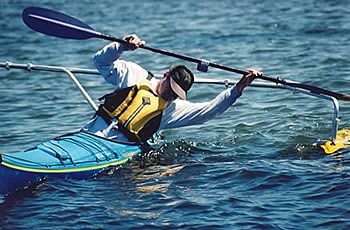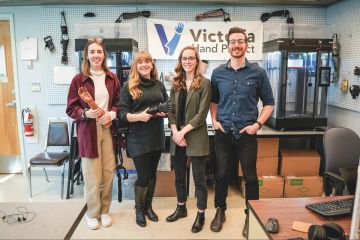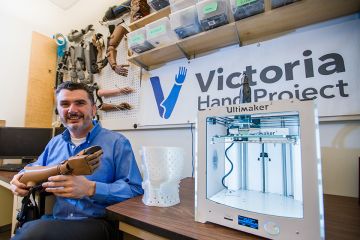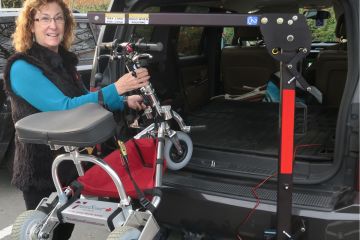UVic team removes barriers to ocean kayaking

Ocean kayaking could soon be the sport
of choice for paraplegics, thanks to the creativity of some UVic mechanical
engineering students.
As part of UVic engineering professor Dr. Colin Bradley’s 2002 fourth-year mechanical engineering class, students modified two ocean kayaks that were donated by Victoria’s Current Designs Kayaks and the Vancouver Island Canoe and Kayak Centre. To date, the class has developed a number of working models with flotation stabilization devices and special rudder control systems that will allow people with lower body impairments to kayak with ease.
“The flotation device is a set of pontoons placed on the kayak so its user can lean from side to side without capsizing the vessel,” Bradley explains. The rolling motion of kayaking makes it difficult to stay upright without good hip control. “The rudder, which would normally be operated using the feet, is radio controlled. It works on the ‘sip and puff’ system (breath control), allowing the user to move the rudder to the left or right without using their arms or legs. We also placed radio-control buttons on the paddle so that the rudder can be manipulated by hand.”
During the three-month course, Bradley’s students gathered background information from users and then presented their ideas for feedback. “You have to go through a standard design technique of floating trial balloons, creating concepts and discussing them with users,” says Bradley. “Otherwise you may end up designing something that can’t be used by the person you’ve designed it for.” The students also had to ensure that the adaptations were reasonably priced ($200 for a stabilizer and $300-$400 for a rudder) and easy to install. To do this they made prototypes and refined their designs over time.
The concept of adapting kayaks with assistive technologies first came to Dr. Doug Nichols, the director of UVic’s school of physical education, in 1982 during a meeting of the B.C. Summer Games Society. “We were asked to devise systems which would allow athletes with disabilities to compete on as level a playing field as possible with their able bodied peers,” Nichols recalls. “The committee developed first-stage prototypes but once Dr. Doug Tolson, the technology transfer manager at UVic’s IDC (Innovation and Development Corporation), and Dr. Bradley got wind of what we were doing—that’s when things really got moving.”
Bradley’s next MECH 400 class will build on the existing prototypes and design and produce more fully operational models. IDC is exploring the possibility of establishing a UVic spin-off entity that would manufacture and sell assistive technologies to persons with disabilities.
As part of UVic engineering professor Dr. Colin Bradley’s 2002 fourth-year mechanical engineering class, students modified two ocean kayaks that were donated by Victoria’s Current Designs Kayaks and the Vancouver Island Canoe and Kayak Centre. To date, the class has developed a number of working models with flotation stabilization devices and special rudder control systems that will allow people with lower body impairments to kayak with ease.
“The flotation device is a set of pontoons placed on the kayak so its user can lean from side to side without capsizing the vessel,” Bradley explains. The rolling motion of kayaking makes it difficult to stay upright without good hip control. “The rudder, which would normally be operated using the feet, is radio controlled. It works on the ‘sip and puff’ system (breath control), allowing the user to move the rudder to the left or right without using their arms or legs. We also placed radio-control buttons on the paddle so that the rudder can be manipulated by hand.”
During the three-month course, Bradley’s students gathered background information from users and then presented their ideas for feedback. “You have to go through a standard design technique of floating trial balloons, creating concepts and discussing them with users,” says Bradley. “Otherwise you may end up designing something that can’t be used by the person you’ve designed it for.” The students also had to ensure that the adaptations were reasonably priced ($200 for a stabilizer and $300-$400 for a rudder) and easy to install. To do this they made prototypes and refined their designs over time.
The concept of adapting kayaks with assistive technologies first came to Dr. Doug Nichols, the director of UVic’s school of physical education, in 1982 during a meeting of the B.C. Summer Games Society. “We were asked to devise systems which would allow athletes with disabilities to compete on as level a playing field as possible with their able bodied peers,” Nichols recalls. “The committee developed first-stage prototypes but once Dr. Doug Tolson, the technology transfer manager at UVic’s IDC (Innovation and Development Corporation), and Dr. Bradley got wind of what we were doing—that’s when things really got moving.”
Bradley’s next MECH 400 class will build on the existing prototypes and design and produce more fully operational models. IDC is exploring the possibility of establishing a UVic spin-off entity that would manufacture and sell assistive technologies to persons with disabilities.
-- 30 --
Photos
There are no images in this gallery.
Media contacts
Dr. Colin Bradley (mechanical engineering) at (250) 721-6031
Dr. Doug Nichols (physical education) at (250) 721-8376 or dnichols@uvic.ca
Dr. Doug Tolson (Innovation and Development Corporation) at (250) 721-6398
Maria Lironi (UVic Communications) at (250) 721-6139 or lironim@uvic.ca
In this story
Keywords: adaptive technology, athletics, sports




